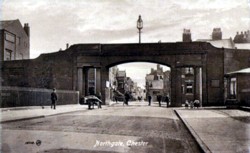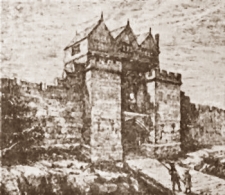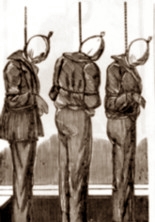Northgate Gaol
The present day Northgate replaced an earlier gate in 1810. Until 1807 the gatehouse of the previous Northgate was used as the infamous City Gaol. Chester was the execution centre for the whole county; the sheriffs were responsible for seeing condemned criminals 'turned off' at the gallows. County and City prisoners were publicly executed over the entrance. It ceased to be a gaol in 1871 and prisoners moved to the County Gaol at the Castle. Men and women were hanged for offences as major as highway robbery or murder, or as trivial as stealing a few yards of cloth. The 'lucky' ones might be reprieved and incarcerated in the notorious gaol, publicly flogged, or transported to Australia.
Until 1807 the gatehouse of the previous Northgate was used as the infamous City Gaol. Chester was the execution centre for the whole county; the sheriffs were responsible for seeing condemned criminals 'turned off' at the gallows. County and City prisoners were publicly executed over the entrance. It ceased to be a gaol in 1871 and prisoners moved to the County Gaol at the Castle. Men and women were hanged for offences as major as highway robbery or murder, or as trivial as stealing a few yards of cloth. The 'lucky' ones might be reprieved and incarcerated in the notorious gaol, publicly flogged, or transported to Australia.

The contemporary historian Hemingway described it as "An inconvenient and unseemly pile of buildings". Both the gate and the gaol were under the control of the city sheriffs. The gaol had its dungeons cut deep into the sandstone, below the city wall. There were no windows in some so the only air prisoners got was by pipe. Parts of the gaol have been excavated from the rock below the wall. Descriptions of it in the 17th century refer to a dark stinking place called 'dead men's room' where prisoners who had been condemned to death were confined.
There was also another cell called 'Little Ease', which was about 1.5 meters high and about half a meter at its greatest in width and depth. It was said that the height could be lessened, as a form of torture, by fixing wooden boards across the cell.
Adjacent to the Northgate and just a few yards to the west of the road bridge which runs high over the canal is a slender, narrow and dangerous looking stone footbridge that links the walls and the Bluecoat building. Known as the Bridge of Sighs, the bridge, which originally had iron railings, was built in 1793 as a means of securing a link between the jail and Little St John's chapel, where there was an apartment made for prisoners. In popular tradition it is said that condemned felons used it to receive their last rights at the chapel, before they came back to execution by the drop where their bodies were dropped and hanged in front of the crowd.
stone footbridge that links the walls and the Bluecoat building. Known as the Bridge of Sighs, the bridge, which originally had iron railings, was built in 1793 as a means of securing a link between the jail and Little St John's chapel, where there was an apartment made for prisoners. In popular tradition it is said that condemned felons used it to receive their last rights at the chapel, before they came back to execution by the drop where their bodies were dropped and hanged in front of the crowd.
Until 1801, public executions took place at  Gallows Hill, in Boughton. The last execution there was particularly gruesome. Three men were in the cart by the scaffold waiting to be hanged, when one John Clare escaped, and fell into the river Dee; the weight of his shackles sent him straight to the river bottom, and he drowned. But the letter of the law had to be carried out; the two other unfortunate men had to wait while Clare's body was fished out of the river, then they were all hanged together. After 1801, condemned men were sent to Northgate Gaol for execution; later on, the city gaol.
Gallows Hill, in Boughton. The last execution there was particularly gruesome. Three men were in the cart by the scaffold waiting to be hanged, when one John Clare escaped, and fell into the river Dee; the weight of his shackles sent him straight to the river bottom, and he drowned. But the letter of the law had to be carried out; the two other unfortunate men had to wait while Clare's body was fished out of the river, then they were all hanged together. After 1801, condemned men were sent to Northgate Gaol for execution; later on, the city gaol.


